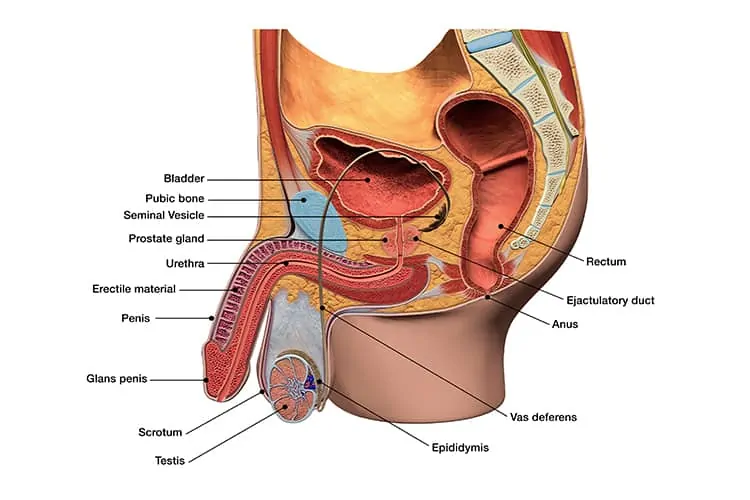Learn more about the sperms' journey through the genital tract and how germs, infections, and sexually transmitted diseases can affect the quality of the sperm.
Male Genital Tract
The male genital tract is a rather grand description of the route that the sperm takes in its journey from the testicles to the point of ejaculation, from the end of the urethra tube in the penis.
Starting from the testicle, the first part of a sperm’s journey is into the Epididymis – a long coiled structure where the sperm mature and gain the ability to move (motility). Once motile they travel in the vas tube, out of the scrotal sac (scrotum), through the groin (the inguinal canal) and all the way to the prostate gland. In the prostate there is a “holding bay” called the Ampulla; behind the prostate but joined to it are the Seminal Vesicles, glands which make most of the volume of the ejaculate. Therefore only 5% of the fluid produced actually comes from the testicles, but it is this part which contains the sperm, which have travelled a long distance during which they can lose quality and motility.
If you want to learn more about the male reproductive system, follow the link to our article featuring a detailed illustration of the male scrotal anatomy.


Sperm Quality and Germs
One of the important causes of this deterioration in sperm quality is inflammation somewhere along this genital tract, which could be caused by a variety of germs that have gained entry into the genital tract from the outside (from the urethra opening). The genital tract is a complicated structure with thousands of little ducts and tubules which come together like a river delta carrying all the components of the ejaculate into the urethra. The urethra itself also has little pockets, or glands along its length. Of course the urethra is open ended, so that organisms and germs do enter the genital tract and are probably present in most men without causing any symptoms or damaging effects. For some men, however, these germs can impact sperm quality.
The more that we look for these organisms in the seminal fluid (the ejaculate which contains the Sperm and all the fluids made throughout the tract) the more often we find all kinds of germs. Sometimes these are ones that we recognise, such as Chlamydia. More often the organisms are typical of those we might find in the gut or even in the mouth.
So, do these unusually placed germs actually matter? We are beginning to be able to distinguish those which do matter from those merely living harmlessly, or more importantly, are beneficially inside us. It seems that what matters for fertility is whether germs are affected these sperm (positively or negatively).
For the germs that do matter, they can lead to an infection and of course when a man has symptoms of infection in the urethra (urethritis), prostate (prostatitis) or epididymis (epididymitis), we would expect to find both germs and the usual signs of infection, such as fever, pain or swelling in the genitals, discomfort in the pelvis or on urinating, and/or a discharge from the penis. It is important that if you have any of these symptoms that you see a doctor or nurse immediately, as some of these infections can be passed on to your partner and can affect female fertility by causing damage to her Uterine (Fallopian) tubes. Sometimes however, men can have an infection with an important cause that needs treating, such as Chlamydia, but may have few or no symptoms. If you think that you may be at risk of having a sexually transmitted disease then you should discuss this with a doctor or nurse, or attend a Sexual Health clinic for a check-up.
The body’s immune system fights infections by producing inflammation and this involves special immune cells called white blood cells.
We also know that these white blood cells can produce chemicals which can sometimes, but not always damage sperm. We are beginning to explore the relationship between inflammation, white cells and an imbalance of chemicals in the seminal fluid, known as Oxidative Stress.
So far it seems that Oxidative Stress, which we can measure, is associated with a reduction in male fertility, which is caused by damage to the DNA package in the sperm head. This damage can be measured by a DNA Fragmentation test.
Where are we now? We are making progress in beginning to understand how to identify the germs, and then to see if they are the cause of oxidative stress and raised DNA Fragmentation. But we need to be careful! Some of these germs in the genital tract may actually be protective, just as they can be in the gut. So, we are at the start of a journey which is just beginning to explain one of the causes of unexplained infertility.



